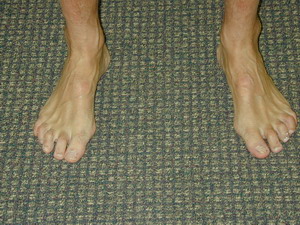High Arched Foot
Pes cavus is defined as foot having an abnormally high medial longitudinal arch.. These feet retain their high-arched appearance when weight bearing, this is the supinated foot type. It is a less common deformity than flat foot (pes planus). Pes cavus is usually bilateral and apparent at an early age. The sudden appearance of the deformity, or its presence unilaterally, may be the result of trauma or neuro-muscular disease. It may be initially asymptomatic, but often becomes progressively symptomatic with age. In many respects, pes cavus is a more bothersome foot type than flatfoot. Less of the plantar surface of the foot is weight bearing resulting in increased stress on the heel and metatarsals. Painful plantar calluses are often present. The toes may develop a "clawing" deformity with painful corns on the top of the toes or at the tips. The high arched foot is very poor at absorbing the shock of heel strike during the gait cycle. This creates abnormal stress on the soft tissues of the heel and mid-tarsal joints (arch). The shock is transmitted up the kinetic chain to the ankle, knees, hips, and lower back. Pain in one or more these areas is fairly common.
Foot orthotic devices can provide support for stressed joints and soft tissues. They are often constructed to increase shock absorption. The redistribution of weight relieves stress on the metatarsals. Generally, custom-made semi-rigid or semi-flexible functional posted orthotics are most effective for this foot type. They often include shock absorbing material in the arch. These devices are prescribed based on a thorough biomechanical examination by a qualified podiatrist. Orthotic therapy is very effective for patients with this foot type. Over-the-counter arch supports may be helpful for mild cases, but they are often a poor fit for persons with this condition.

Symptoms
---------------------------------------------------
•Pain and stiffness of the medial arch or anywhere along the mid-portion of the foot
•There may be associated discomfort within and near the ankle joint
•The knees, hips, and lower back may be the primary source of discomfort
•Pain in the ball of the foot, with or without calluses
•Heel pain
Causes
---------------------------------------------------
•Unknown, probably a genetic predisposition
•Congenital conditions (e.g. cerebral palsy, congenital club foot)
•Neuro-muscular disease (e.g. poliomyelitis, Charcot-Marie-Tooth disease)
•Nerve trauma
What you can do
---------------------------------------------------
•Wear shoes with a good cushioning and arch support
•Control body weight to decrease load on the feet
•Home care of associated corns and calluses
What the doctor may do
---------------------------------------------------
•Prescribe physical therapy modalities
•Recommend shoes
•Prescribe functional foot orthotic devices to support the foot, redistribute weight, and absorb shock.
•Surgically correct a severe symptomatic high arched foot
Complications of the high arched foot
---------------------------------------------------
•Pain in the heel and sole of the foot from plantar fasciitis.
•"Pump bumps" (Haglund's deformity) on the back of the heel
•Tight Achilles tendons
•Ankle instability with frequent sprains
•Morton's neuroma with pain in the ball of the foot and lesser toes.
•Strain and early degenerative joint disease (osteoarthritis) of lower extremity joints
•High arched feet are are more prone to develop painful contractures of the toes and calluses.
•Metatarsalgia with pain in the forefoot
•Stress fractures of the metatarsals and other foot bones
•Particularly in diabetics and those with compromised circulation, abnormal pressure may result in chromic ulcers of the heel and ball of the foot.
•Chronic lower extremity pain my lead to inactivity and diminished well-being
Foot orthotic devices can provide support for stressed joints and soft tissues. They are often constructed to increase shock absorption. The redistribution of weight relieves stress on the metatarsals. Generally, custom-made semi-rigid or semi-flexible functional posted orthotics are most effective for this foot type. They often include shock absorbing material in the arch. These devices are prescribed based on a thorough biomechanical examination by a qualified podiatrist. Orthotic therapy is very effective for patients with this foot type. Over-the-counter arch supports may be helpful for mild cases, but they are often a poor fit for persons with this condition.

Symptoms
---------------------------------------------------
•Pain and stiffness of the medial arch or anywhere along the mid-portion of the foot
•There may be associated discomfort within and near the ankle joint
•The knees, hips, and lower back may be the primary source of discomfort
•Pain in the ball of the foot, with or without calluses
•Heel pain
Causes
---------------------------------------------------
•Unknown, probably a genetic predisposition
•Congenital conditions (e.g. cerebral palsy, congenital club foot)
•Neuro-muscular disease (e.g. poliomyelitis, Charcot-Marie-Tooth disease)
•Nerve trauma
What you can do
---------------------------------------------------
•Wear shoes with a good cushioning and arch support
•Control body weight to decrease load on the feet
•Home care of associated corns and calluses
What the doctor may do
---------------------------------------------------
•Prescribe physical therapy modalities
•Recommend shoes
•Prescribe functional foot orthotic devices to support the foot, redistribute weight, and absorb shock.
•Surgically correct a severe symptomatic high arched foot
Complications of the high arched foot
---------------------------------------------------
•Pain in the heel and sole of the foot from plantar fasciitis.
•"Pump bumps" (Haglund's deformity) on the back of the heel
•Tight Achilles tendons
•Ankle instability with frequent sprains
•Morton's neuroma with pain in the ball of the foot and lesser toes.
•Strain and early degenerative joint disease (osteoarthritis) of lower extremity joints
•High arched feet are are more prone to develop painful contractures of the toes and calluses.
•Metatarsalgia with pain in the forefoot
•Stress fractures of the metatarsals and other foot bones
•Particularly in diabetics and those with compromised circulation, abnormal pressure may result in chromic ulcers of the heel and ball of the foot.
•Chronic lower extremity pain my lead to inactivity and diminished well-being
